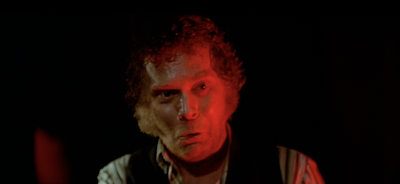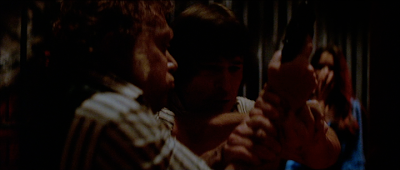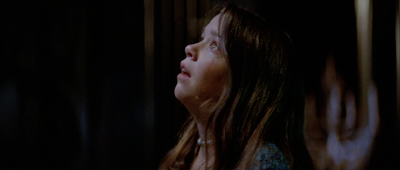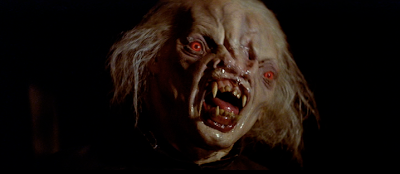[DOORS CREAKING]
[DOORS SLAM]
BUZZ: "Let's try over here."
[CARTS BANGING AGAINST DOORS]
The "end of the line" is about to become
punishingly literal for Buzz and Amy, as portended by the carts banging
on death's door (signified with skull and crossbones.)
JR: Of course the funhouse is expansive beyond rationale, but the geography is mapped acutely - Buzz and Amy go from King Kong mouth, to chandelier/glass room, to cobweb darkness, to red-lit end of the line and we'll see Amy travel back through each of these rooms alone in her journey back as she officially becomes the Final Girl.
BUZZ: "Everything's locked."
When one of the dolls in the background stirs and we realize it's The Barker, there's been a nervous chuckle of surprise from audiences both times I have seen The Funhouse in a movie theater. The response is that of finally been tricked by a trick you knew was coming. Hooper has been alluding to the danger of mistaken identity and camouflage in this house of mannequins ever since the teens were detected, specifically with the stabbing motions of the doll from whom Buzz plucked a dagger. In the hands of any other director, I think we would've seen this "killer hiding amongst the dolls" gag three times throughout the film but in accordance with the film's unpredictability, Hooper does it just once and waits until we are at our most off-guard. A significantly ironic detail is that Buzz and Amy don't actually notice this deception - only we, the audience do.
JR: It's also hardly emphasized - it's not clear that the Barker is pretending to be a doll or anything. He may just be standing really really still, while hiding.
BARKER: "I've been expecting you."
AMY: [SCREAMS] "BUZZ!"
BARKER: "Hold it there, sonny! Drop that knife."
Being confronted by a villain with a gun is certainly anomalous in "Slasher" films.
JR: Yes indeed. The diopter stylization, the circumscribed use of singling shots between the opposing parties (a typical sort of Hooperian dialectic) and the clear moral opposition - enhanced by the stylized mise en scene - make this sequence fit for The Lady of Shanghai (or some lesser classic Hollywood noir.)
BARKER: "I said drop it!"
AMY: "Why are you DOING this?"
BARKER: "I'm just protecting my family."
AMY: "Your FAMILY?"
AMY: "It's not even HUMAN!"
BUZZ: "The lord works in mysterious ways, little lady."
Amy really comes off as, if you'll pardon my language, an insensitive cunt in this scene by saying the Barker's son isn't even human. Then again, given her circumstances, I wouldn't exactly be thinking about how to get The Monster admitted to a charity for facial reconstructive surgery, either.
JR: Princess Amy is definitely in full tilt in this scene. The Barker has a pretty genius retort, in that homespun Red State skewed hick wisdom sort of way.
I agree with JR, as chillingly calm and matter-of-fact the Barker is in this scene, there's just a hint of sympathy for him in being reminded that the compassion he shows for his freak son is the strongest emotional bond - arguably the only one - in the entire film. "The Lord works in mysterious ways" is a cliched proverb in life as well as the movies, usually inserted into the mouths of obsequious Christians by ambivalent screenwriters, but if this isn't the most appropriate utterance of the expression in horror movie history...the religious subtext of The Funhouse, made explicit by the Bag Lady's warning to Amy that God is watching her, gets its other spoken declaration from the Barker.
BARKER: "Oh hell, he ain't such a bed fella."
"He does get himself in all sorts of trouble though, don't he?"
"Anyway...blood is thicker than water."
"And I'm sure he's gonna be a real comfort to me in my old age."
Of course, let's not forget that while the Barker's fatherly protection for his deformed son is admirable, it's also brought him off his rocker. His sarcastic commentary to Buzz and Amy about the challenges of parenting an unruly child sounds like the desperate humor of a sane man who knows how insane his life has become, but has decided to grin and bear it. Hooper's filmography is full of self-justified madmen, but only The Barker's gallows humor reveals this particular level of distanced self-deprecation. His line about The Monster being a comfort to him in his old age lingers uneasily precisely because I'm unsure if this is another joke or not - can you really picture the mentally retarded and psychotic son in his Frankenstein mask being a "real comfort" to anyone in their old age?
The second immediate use of a old fashioned homespun proverb, "Blood is thicker than water" bookends the sentiment expressed by the first one. As the Freak Tent Barker warned, "These are creatures of God,
ladies and gentlemen." Frankenstein, the original monster-son, may have
been cooked up in a laboratory by a scientist, but The Barker will never
disown his creation the way Victor von Frankenstein did.
BARKER: "Now..."
"How many people know you're here?"
AMY: "Lots."
AMY: "They ALL know."
"Well, no matter. We'll be pullin' outta here tomorrow mornin'.
There's plenty of other carnivals around."
BUZZ: "What'd you do with the other girl?"
"Oh, I expect by now he's just finishing up with her...
We'll just wait here 'til he gets back."
The Barker's cold rationality in this exchange always strikes me as stomach-clenchingly suspenseful, the logical peak of his entirely non-psychotic motive for why the teens must die: a murder has been witnessed. When he asks Amy how many people know she and her friends are here, there's a flicker of hope as if some possible answer could turn the tables - Amy is all too eager to blatantly bluff, and although the Barker doesn't know it (or care either way) she's paid a psychic price for having to lie in the first place. First she used deception to spend the night in the funhouse, now she thinks she can perhaps talk her way out as well. Oh what a tangled web we weave, when first we practice to deceive.
JR: It's pretty genius having the Barker say, "We'll just wait here until he gets back," because that makes perfect sense. The Barker doesn't want to kill anyone - he has a public image and a public function he values, and also a mutant son who murders people anyway!
[CART MOVING]
[DOLLS LAUGHING]
AMY: [SCREAMS]
The dolls' sudden laughter at the arrival of Richie's body in the ride cart is another fantastic instance of the funhouse being "alive" in a way that doesn't come off as magically impossible, but organic to the inverted notion of the funhouse-as-the-film-we're-watching, thanks to a punctuating sting of accompaniment by John Beal's music.
BARKER: "Oh, my my!"
"That is a GRUESOME sight!"
Extending this funhouse-as-film feeling even further, The Barker's little indulgence in sadism is absolutely the voice of a character stepping outside their own film to comment as a spectator. It's practically the voice of Hooper, marveling at his own handiwork. Within the world of The Funhouse and the characters' lives beyond our time with them, it's a character moment that suggests once long ago, The Barker was a guy who became a carny because he genuinely loved the show business of scaring people. He certainly commits to the delivery of his "who will dare to face the challenge" spiel. Creepily, the audience identification endears him to us while simultaneously, it's his only behavior which you could say is truly evil - his mockery of Amy's horror.
JR: The doll seen behind Richie, mirroring him, is one I can't really figure out, but a stick-thing protrudes out of his face a la Richie and the axe.
Buzz jumps the Barker and we have another movie trope turned on its head: one imagines the audience shouting "Get him, he's just an old guy!" if he hadn't attempted anything, and yet as we'll soon find out, it's an even match - this old guy knows how to fight, and Buzz barely lands a single punch. As Richie's trickery and Liz's sexuality fail to save them, so too will Buzz unsuccessfully rely on his key attribute. Testing your strength with a carnival mallet and bell to win a kewpie doll is one thing, The Funhouse seems to say, but don't confuse that with the kind of strength that counts in real life.
[GUN FIRES]
AMY: [SCREAMS]
[BUZZ AND BARKER GRUNTING]
AMY: "No!"
JR: Hooper stages the fight scene not only as a masculine row between Buzz and the Barker, but as a test that reflects right back at Amy. Hooper makes sure to get her witnessing shots as she encircles the circling fighters, and it becomes clearly a show for her - one in which we gain the position to gauge her as spectator. Except she's not only a depraved spectator - she has money in this fight. She stands aloof, determined to keep her pedestal as the damsel and the knight-in-shining-armor's innocent date, but she's got blood in this game that goes beyond the usual damsel's love for her man and her idealized innocence.
AMY: "Get him, Buzz!"
It's at this point when John Beal's score - and Kevin Conway's frenzied expression - indicates to us that while Buzz seems to have the upper hand, The Barker is not going to go down in a fair match of sheer physical force.
BARKER: "Oh, you're REAL tough...ain't you, son?"
The Barker's dialogue throughout this sequence really doesn't leave a thematic stone unturned - from the Lord's mysterious ways to the amusement of gruesome sights, and now, finally, the arrogance of youth being shown up by the toughness of the adult world.
BARKER: "Come on!"
"Come on - get up!"
"Come on, come on!"
AMY: [SCREAMS] "GET UP!"
JR: Between Amy's wailing tears and her screaming at Buzz to "get up, get up!" she retains her femininity, but she's now a coward - someone totally, selfishly attached to keeping her life, and a creepy betting club patron throwing bills down at his rooster in the circle. The later petrified "witnessing" shots of Amy when she's standing in the bathing red light - as Buzz goes and has an extended struggle with an impaled Barker - culminate exquisitely this representation of a new, always-waiting, still-complacent but now bloodied and sundered Amy.
BARKER: "Come on!"
"Come on!"
Gotta love The Barker's Marquess of Queensberry fighting stance here, and hesitation to kick Buzz when he's down. What a gentleman.
"Come on!"
BUZZ: [YELLS]
[SOUND OF IMPALEMENT]
AMY: [SCREAMS]
BARKER: [SCREAMS]
BARKER: [GROANING]
In light of Buzz's would-be status as a knight in armor to Amy, the Barker's fatal wounding on an armored knight's sword seems like it had to have been deliberate.
Bruce Kawin, the only film critic to give serious subtextual attention to The Funhouse upon its initial release, sees the Barker's death as a highly arch commentary the Slasher subgenre's "rape by steel" trope - part of what he called "Ruthless caricatures of phallic agression...absolutely never validated as it is in Halloween."
"To take an explicit example: the father / barker who owns the funhouse (played by Kevin Conway, last seen in "The Lathe of Heaven") is killed by being thrust onto a sword held by a mannequin; it protrudes through the front of his belly, and he grasps it like an erection."
AMY: [CRYING] "OHH!"
AMY: [CRYING]
BUZZ: "You all right?"
AMY: "Oh my god!"
BUZZ: "He's gotta have a set of keys on him."
AMY: [SCREAMS] "NO!"
AMY: "Buzz, no!!"
[GUNSHOTS]
Kawin again:
"In a slightly reversed echo of Malory's "Morte d'Arthur" (Mordred's killing his father by hauling himself along the spear that has impaled him), the barker tries to kill but only wounds the male good guy, Buzz, by forcing him belly first onto that sword, in a homoerotic patriarchal nightmare that could not possibly please the audience."
[GUNSHOTS]
Hooper never misses a good opportunity for drooling in this picture, using it here as a signifier of the Barker's demise.
MONSTER: [GROWLING]
AMY: [SCREAMS]
In this severe "Oh shit" moment, Beal's music brings low-tone horns to announce imminent doom in a way I don't believe happens anywhere else in the score. Listen for it.
BUZZ: "Get the hell out of here!!"
Tellingly, The Monster gestures at Amy menacingly, but does not strike at her - he seems more intent on frightening than attacking. As with Liz, he seems as intimidated by beautiful young girls as they are terrified of him, and his motive with Amy appears to be purely intimidation, a kind of self-assertion to prove that his monstrous status empowers him.
BUZZ: "RUN!!"
AMY: [SCREAMS]
MONSTER: [SCREECHES]
[GUN CLICKS]
The real "Oh shit" moment is, naturally, the sudden avenging rage of The Monster for his dead father and sudden impotence of The Barker's empty revolver chambers. Buzz is very much in just as terrifying a place as Liz was when faced against the beast, but with zero remaining possibilities for escape. Wayne Doba's mime skills here are just fantastic - shifting from aggression to anguish to righteous fury in just a few seconds. His skittery animal energy is given a graceful flourish too, when spinning around nearly 360 degrees to face Buzz twice.
[GUNSHOT]
CLOWN DOLL: [CHUCKLING]
Time for more nervous laughter from the audience: this clown doll's low pitched, continuously monotonous "Ho, ho, ho, ho..." chuckle is brought up on the soundtrack just as John Beal's strains of excitement lull, and the dead laughter comments on Amy's overly optimistic decision to stop running and find out if the gunshot we heard was Buzz felling the Monster: as a horror film audience, we know better than to hold onto such a hope. Amy doesn't, of course - hence the punditry of this white death's head.
With the emergence of Buzz's dead body in the arms of (what else) another white-faced clown, Beal's horror motif reemerges on the soundtrack to drown out the funhouse's sound effects and operatically reinforce Amy's new terror at being all alone, with no one left who can possibly help her.
AMY: "Oh my god..."
AMY: [CRYING]
JR: Something of a "celebrated" shot from the film (it's the honored still at the film's page on the movie website MUBI), the graphic pairing of Amy and a bobble-headed clown in a shimmery room of glass is indeed one of the most visually striking and demented in the film. Seen most simply, it presents Amy alongside a mocking jester laughing at her extreme misfortune. But to push the design further, there's a certain element of comparison going on here that isn't accounted for in that reading. Amy is not just with the clown, she's graphically matched with it. Mismatched proportionality and all, she is made to stand at its height in the frame, pressed up against it like buddies tied at the hip. This can suggest a number of things: perhaps, that Amy's current state is just the terrified flipside of the grotesque clown's happy insanity. Or, more to my feelings, that the happy clown is Amy: both ugly and marginal in a funhouse world, both low on the unclimbable totem pole, one (the clown) hoping to remind the other (Amy) that laughter is possible even at their sad status.
"Nooo!"
JR: This entire sequence in the glass room is one of mismatched yet relatable proportions. Here, Amy and the clown are different, but the same. Soon, in the basement, Amy will face The Monster and again, they are different, but the same. It's an entire scene of Mannerist influence: disproportionate figures and elongated forms, collapsed perspective and unreadable space, asymmetry, incongruous colors, precariously balanced poses, irrational settings, and theatrical lighting.
[JINGLING]
Hooper's
camera swoop towards Amy crying just before she notices the phony
chandelier shaking above her has always been an odd move to me;
seemingly pointless. On repeat viewings, however, I think it was
intended to put us closer to Amy's state of vulnerability so that, like
she does, we momentarily think the chandelier could actually fall atop
us instead of recognizing that it's just another funhouse prop -
foreshadowing the montage of fake dangers about to occur.
[FLOORS CREAKING]
[HOWLING SOUND]
[THUNDER AND LIGHTNING SOUNDS]
As King Kong's mouth shuts, so begins the freakout montage every viewer has to have seen coming and John Beal's score melts into a nightmarish fugue, punctuated by the funhouse's cheesy-cum-sinister sound effects that's absolutely sublime. Like The Barker hiding amongst the dolls, this is something that could've been done more than once in the film but in a remarkable show of restraint, Hooper waits until the best time for maximum effectiveness. Unfortunately, I think it's lost much of the disorienting power it must have had in 1981 because today we're sort of jaded towards rapid editing montages being used in film and tv to depict the panicked mental state of a character both mentally and physically lost.
JR: When I first watched the film, I thought, "Aw, he's falling back on freaky montage." But now, I love the sequence.
[EYE CREAKING]
MONSTER: [SCREECHES]
The flashes of the monster are of course in Amy's head, something which doesn't really come across in my selection of still images. Another aspect of the montage to which freeze frames can't do justice - but should be kept in mind when assessing the sequence - is Hooper's use of whip-pans to Amy and the funhouse dolls to simulate her frenzied looking about in all directions. This subjective camerawork to empathize with a protagonist's state of total terror is very much a callback to Marilyn Burns' rapidly edited hysteria as a captive at Leatherface's dinner table in The Texas Chainsaw Massacre. The major difference between the two is that the editing of Chainsaw's montage feels totally unhinged whereas The Funhouse definitely has more formalism and order behind the craziness, which gives Chainsaw the edge, I think.
[HOWLING SOUND]
WITCH DOLL: [CACKLING]
JR: Though it can easily be dismissed, this shock-montage sequence is really more meaningful in purpose and more artful than any comparable to it in any comparable horror film. First, the use of the assorted puppets, arbitrary to their placement in the funhouse (some maybe even existing only in the opening credits) suggests a meta-filmic moment that considers the "concept" of the funhouse (or the film itself) as the reckoning thing over Amy - and, by substitution, the audience. As she learns (from a world of avatars) so too, the film hopes, we the audience do also.
DOLL: [GROWLING]
[EYE CREAKING]
JR: It's also amazingly edited. The longer-duration shots of Amy, slowly baking away from or staring into some great unknowable fear, are the sublime anchors of the sequence, shaping it into something exquisite. Also, the flash cuts of the monsters are an excellent expression of trauma about something she doesn't quite understand.
GHOUL HEAD: [LAUGHING]
BEAST HEAD: [GRUNTING]
The choices of some of these particular dolls - the beast head above and a similar ape-like one earlier - are well thought out to resemble the fangs of The Monster himself.
MONSTER: [SCREECHES]
[EVIL LAUGHTER]
[EVIL CACKLING]
GORILLA DOLL: [GROWLING]
[EVIL CACKLING]
EXECUTIONER DOLL: [LAUGHING]
[EVIL CACKLING]
SKELETON DOLL: [LAUGHING]
[HOWLING SOUND]
This last thing Amy sees before finding her way back to the Barker's storeroom can only be interpreted as a hallucination - the bodies of Richie and Liz, perhaps? It's a rare thing for Hooper to do, but he also does the same psych-out just a little bit in The Texas Chainsaw Massacre Part 2 when Caroline Williams runs through a tunnel of (actual) skeletal victims of Leatherface's family, and the soundtrack echoes with unnerving sounds of laughter and screams.
JR: Yeah, Ken Russell-like hallucination trip-outs like the skeletons doesn't seem like his sort of thing. Night Terrors is filled with explicit dream/drug-trip scenes, but not even then does he concoct surreal, art-designed visions to throw at the viewer randomly like he does here. Definitely anomalous. I find it pretty haunting.
MONSTER: [GROWLS]
[HOWLING SOUND]
AMY: [SCREAMS]
[DOLLS LAUGHING]
AMY: [GASPS]
MONSTER: [GROWLS]
MONSTER: [GRUNTING]
JR: At this point, the journey is not about being scared, it's about playing out to its logical end: a face-off with the monster. Amy's nonchalant discovery of a magic escape hatch goes hand-in-hand with the lack of music from this point on. Notice when The Monster crashes through the door, there is not another uptake in scary music. This is about passive players carrying out a scenario that can end only two ways: she and The Monster face off, or she somehow escapes and avoids The Monster altogether, either sooner or later (Amy obviously choosing later.)
MONSTER: [GRUNTING]
Even while clumsily clawing through a door, Wayne Doba's poses register all the right notes. Witness this piece of art from self-proclaimed "horror artist" Chris Kuchta, based on the final shot:
Check back next month for Amy's big Final Girl moment...


































































































































































































































































































Let the world fall into pieces tomorrow, let the planets collide and the stars come tumbling down. I dont need another day now that my dream has come true. Lucky me, now I have you. See the link below for more info.
ReplyDelete#collide
www.ufgop.org